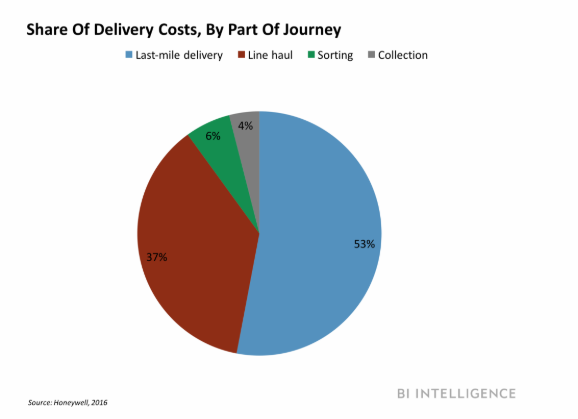AUTHOR: Shelagh Dolan
PUBLISHED | May 10, 2018
As consumers increasingly turn to e-commerce for all their shopping needs, speedy fulfillment isn’t just a “nice to have” — it’s the expectation of every online shopping experience. And if logistics companies and their retail partners want a shot at thwarting the ever-looming threat of Amazon Prime, it needs to be a priority.
Breakdown of transportation costs by leg including last mile deliveryBI Intelligence
As a result, businesses have begun racing to develop new technologies and experimental supply chain models to increase parcel volume, expedite deliveries, and delight customers — all while trying to cut costs. Unfortunately, one of their biggest expenses and challenges is same-day, last mile shipping.
In a new report from Business Insider Intelligence, we take a look at shipping logistics, the last mile problem, and how companies can adapt to the new challenges of e-commerce shipping. Read on to learn some of the highlights of this increasingly prevalent disruption.
What is last mile delivery?
In a product’s journey from warehouse shelf to customer doorstep, the “last mile” of delivery is the final step of the process — the point at which the package finally arrives at the buyer’s door. In addition to being a key to customer satisfaction, last mile delivery is both the most expensive and time-consuming part of the shipping process.
What is the last mile problem?
If you’ve ever tracked a package online and saw that it was “out for delivery” for what felt like forever, you already understand that the last mile problem is inefficiency. That’s because the final leg of shipment typically involves multiple stops with low drop sizes.
In rural areas, delivery points along a particular route could be several miles apart, with only one or two packages getting dropped off at each one. In cities, the outlook isn’t much better; what urban areas make up for in stop proximity is quickly negated by the near constant delays of traffic congestion.
The costs and inefficiencies of the last mile problem have only been further compounded by the continuous rise of e-commerce in US retail sales, which has dramatically increased the number of parcels delivered each day, as well as raised customer expectations to include not just fast, but also free, delivery.
What are the costs of last mile delivery?
As a share of the total cost of shipping, last mile delivery costs are substantial — comprising 53% overall. And with the growing ubiquitousness of “free shipping,” customers are less willing to foot a delivery fee, forcing retailers and logistics partners to shoulder the cost. As such, it’s become the first place they’re looking to implement new technologies and drive process improvements.
Technology solutions to improve last mile logistics
With the rise of the gig economy, many consumers are already familiar with the concept of crowdsourcing local services through digital platforms like Uber, Airbnb, and Postmates. Location-based crowdsourcing allows consumers to open a mobile app to hail a ride, book a place to stay, order coffee to the office, hire a handyman to mount a TV, send flowers to that special someone, or even schedule takeout to arrive just as they’re walking through their apartment door.
The crowdsourcing model has been prevalent in transportation, hospitality, and food delivery for some time now, and retailers are eyeing its low startup costs, asset-light operations, and improved customer experience to ease their last mile delivery woes.
With crowdsource technology, retailers, logistics partners, and consumers can connect directly with local, non-professional couriers who use their own transportation to make deliveries. Companies can get their online orders to customers faster, and customers can get their items when and where they want them. The freedom to make on-demand and scheduled deliveries also ensures that customers are home at the time of delivery — eliminating the need for a second (or third) attempt.
And with the ongoing integration and enhancement of automation across industries, it’s likely we’ll start seeing delivery robots, drones, and self-driving vehicles making many of these drop-offs in the not-so-far future.
Explore last mile logistics challenges, solutions and trends
Business Insider Intelligence, Business Insider's premium research service, has written a detailed report on crowdsourced delivery that:
- Details the factors driving investment and growth in crowdsourced delivery startups.
- Examines the benefits and drawbacks of using crowdsourcing to deliver online orders.
- Explains how crowdsourced delivery startups can improve their cost efficiencies to tackle greater delivery volumes
- Explores the role that crowdsourcing will play in the future of delivery once automated delivery options, like drones and robots, arrive.
Here are some of the key takeaways from the report:
- Retailers are looking for ways to deliver goods faster to consumers' doorsteps to stave off Amazon's threat and meet customer expectations.
- To accomplish that, retailers and delivery providers are zeroing in on the "last mile" of fulfillment, the most expensive and time-consuming part of the delivery process, which is when a package reaches the customer's address.
- Startups like Postmates, Instacart, and others are looking to disrupt the last mile delivery space by leveraging the "Uber model," and connecting businesses to non-professional couriers who can deliver goods instantly.
- Crowdsourcing can drastically speed up deliveries in urban areas, where there is a high density of deliveries and potential couriers to be matched.
- However, as delivery volumes increase, crowdsourced delivery startups will need to further optimize their deliveries to improve cost efficiencies.
- Many of the deliveries these startups perform today will likely be automated in the future, raising the possibility that these startups may eventually look to incorporate new technologies like delivery drones or self-driving delivery vehicles.
Source: Business Insider


